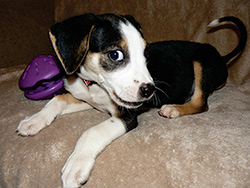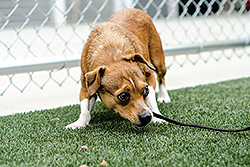What does it mean when your dog barks at strangers but wiggles his body and gives them whale eye? Or what does it mean when a dog comes towards you with a wagging tail, a stiff body and pinned back ears? Wouldn’t it be wonderful to have a window into a dog’s mind to know what he’s thinking? You can gain the most clues to how a dog’s feeling just by watching him closely.
 The ability to produce nuanced facial expressions is key to the human-dog bond, and, in fact, when humans domesticated dogs, close attention was paid to the facial expressions that dogs produce, according to researchers with Duquesne University in Pittsburgh, Pennsylvania. The ability to produce nuanced facial expressions is key to the human-dog bond, and, in fact, when humans domesticated dogs, close attention was paid to the facial expressions that dogs produce, according to researchers with Duquesne University in Pittsburgh, Pennsylvania.
Dogs’ body language reveals emotions and intentions much like it does in humans. And just like you can gauge someone’s mood by evaluating their face, dogs’ facial expressions also reveal how your dog may be feeling. The key is to learn what your dog’s facial expressions mean and how to spot their sometimes-subtle differences.
What do the Eyes tell you?
• The first step to evaluating your dog’s facial expressions lies with their eyes. Pat Miller, Whole Dog Journal’s training editor, summed up several common eye expressions in dogs, and what they mean
• Soft eye contact — Round or almond-shaped eyes with a soft gaze, often seen alongside a relaxed tail wag and a curved or wiggling body. This is a sign that your dog is feeling confident and friendly.
• Hard eye contact — A hard, direct stare with piercing eyes, often accompanied by assertive body language, such as an erect tail and a tall, forward body stance. “This may be part of a pre-aggression ‘freeze’ where the dog goes completely still,” Miller said. “If this warning is ignored, the dog is likely to bite.”
• Squinty eyes — Dogs may squint in a sign of appeasement, which can have multiple underlying meanings. If your dog is approaching you and squinting, it’s likely a friendly, social expression from a dog that just likes to appease. However, squinting accompanied by fearful body language, such as a back and lowered body posture, it can be a sign of fear and a signal that he’s about to bite.
• Eye contact avoidance —It’s normal for dogs to avert their gaze when looking at you; it’s a signal that they’re not trying to challenge you.
• Whale eye — This describes the white portion of the eye showing at the corner or rim, and it’s often a sign of anxiety. Whale eye occurs when your dog is looking sideways but keeping his nose pointed forward, which may occur while he’s keeping his nose pointed at a resource, like food, but evaluating his surroundings for threats. If whale eye occurs along with aggressive body signals, it should be taken as such, but if not, it could just be a sign of playfulness.
What do the ears communicate?
The eyes only tell one part of the story when it comes to how your dog’s feeling. You’ll also need to weigh in what his ears are doing:
• Ears pricked forward — Your dog is alert and aroused. This could be a sign that he’s ready to play or a sign that he’s feeling aggressive. To determine which, you’ve got to look at the eyes and body language.
• Relaxed — If your dog’s ears are relaxed, it’s likely your dog is too.
• Ears pulled back — Ears pinned back against the head can be a sign of appeasement, fear or stress. Evaluate the rest of your dog’s body language to determine which sign your dog is displaying.
The Mouth speaks too:
Your dog’s mouth also reveals valuable clues about your dog’s state of mind. When viewed alongside his eyes and ears, it can provide a reliable indicator of how your dog is feeling
• Relaxed — A relaxed mouth — closed or slightly open — is typically a sign of a relaxed dog.
• Tense — A mouth that’s slowly closed and has lines around it is an indication of aggression — often as part of the freeze sequence that occurs before a bite.
• Yawning — Dogs may yawn as a calming signal, which describes a method of communication used to promote peace and stave off aggression within the pack. Most humans miss this subtle cue from their dog, so if you notice your dog yawning out of the blue, it could be a sign that he’s feeling stressed or anxious. A yawn can also indicate that your dog’s tired, or that you just yawned, since yawning is contagious.
• Licking — Dogs lick for many reasons. It could be due to a medical issue, stress, appeasement or simply because they ate something tasty. Use your dog’s other body signals to determine what your dog’s licking means.
• Submissive grin — Often mistaken for a snarl, a submissive grin exposes your dog’s teeth similar to a human smile. It’s unknown why dogs do this, but it’s been suggested that they’re trying to mimic human smiles.
Overall, dogs are capable of making many facial expressions, including many that are human-like. Research suggests that the evolution of faster facial muscles in dogs has allowed them to move their faces in cuter, more human-like ways, cementing the bond between humans and dogs, as opposed to wolves, which have retained their more wild faces.
Understanding your dog’s overall body language is one of the most important communication skills you can learn about your pup, but if you want to feel closer to your dog and better understand how he might be feeling, spend some time looking at his face, which will reveal his mood to anyone who cares to know. Consider that wagging tails or louds barks don’t always mean what we think, and dogs use their whole bodies to talk to us we just need to learn their language.
|